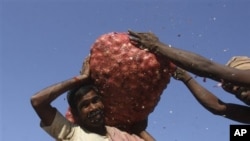Rising inflation in Asia has sparked concern that it could stifle economic growth in the region and the world.
At a market in Jakarta the price of red chili peppers is almost double what it was last year. The increase causes concern here since peppers are a key ingredient in almost every Indonesian meal. But some consumers, like Jarwati, say they are adjusting.
She says people who used to buy one kilo now only buy half a kilo. People who buy 250 grams, now they only buy 100 grams.
Food prices are rising in much of Asia. Global prices for oil, iron, coal and other commodities also are rising.
And in China property values are skyrocketing. Mr. Zhu owns an old apartment building in Beijing where units sell for 43,000 yuan per square meter, the equivalent of $6,500.
He says the biggest change has definitely been price. It used to be a few thousand yuan per square meter, or even a few hundred, to now tens and hundreds of thousands.
The small, one-bedroom apartments in his building are now selling for more than $350,000 each and are usually sold very quickly.
Some economists worry that inflation could erode the purchasing power of Asia’s emerging middle class. But securities analyst Nicholas Cashmore says in some Asian countries inflation reflects a rise in incomes and economic growth.
"There's a lot of countries I think in the world today that would like inflation," said Cashmore. "A modest inflation is always good because it represents that there is demand. And it represents a growing economy."
He says in some Asian countries, like Indonesia, incomes have risen sharply in the past five years. These growing economies, he says, can handle an inflation rate of up to 5 percent. However, in some countries, including Indonesia, inflation now tops 6 percent a year.
And even in countries with robust growth, such as Indonesia, India and China, rising food prices impose hardships. Nagesh Kumar is the chief economist for the United Nations Economic and Social Commission for Asia and the Pacific. He says in Asia, 980 million people live on less than $1.25 a day, and most of their incomes go to food.
"For them it means much more hardship, and then much lesser nutrition," said Kumar. "And some of the people who are just above the poverty line, because of rising food prices, they may also be pushed into poverty. So the result would be that under-nutrition, malnutrition increasing, and that leading to some health problems later on. So, this is a very serious problem for many Asian economies, especially in South Asian economies."
In developed countries, such as South Korea, food accounts for a relatively small percentage of a household budget. But even for them, inflation creates political and economic headaches, which Kumar says governments will try to control. He says that could slow Asia’s strong recovery from the global financial crisis.
"In 2010 they [Asian economies] recover rather well from the crisis," added Kumar. "But now, central banks everywhere, you see that there is a trend that they are raising policy rates to curb the money supply. And that process is likely to affect the growth momentum."
In recent months, central banks in China, Indonesia and elsewhere have raised interest rates to try to slow price increases.
Rising commodity and energy prices mean more factories are producing more goods, which means there is economic growth in Asia and the world. But, Kumar notes, with crop failures in several parts of the world and falling investment in agriculture in much of Asia, food inflation may lead to suffering for many people and more problems for governments.











